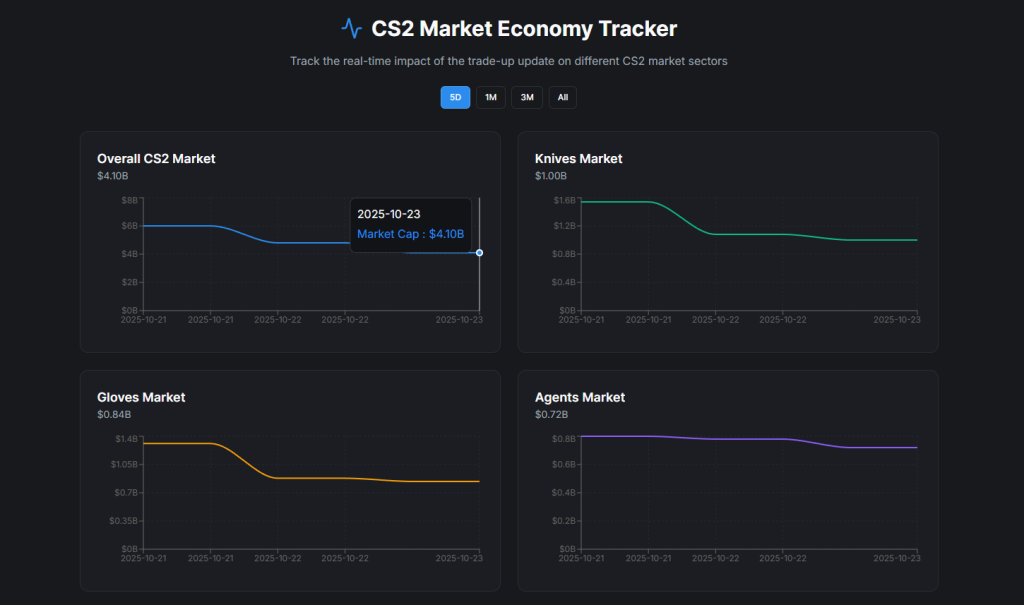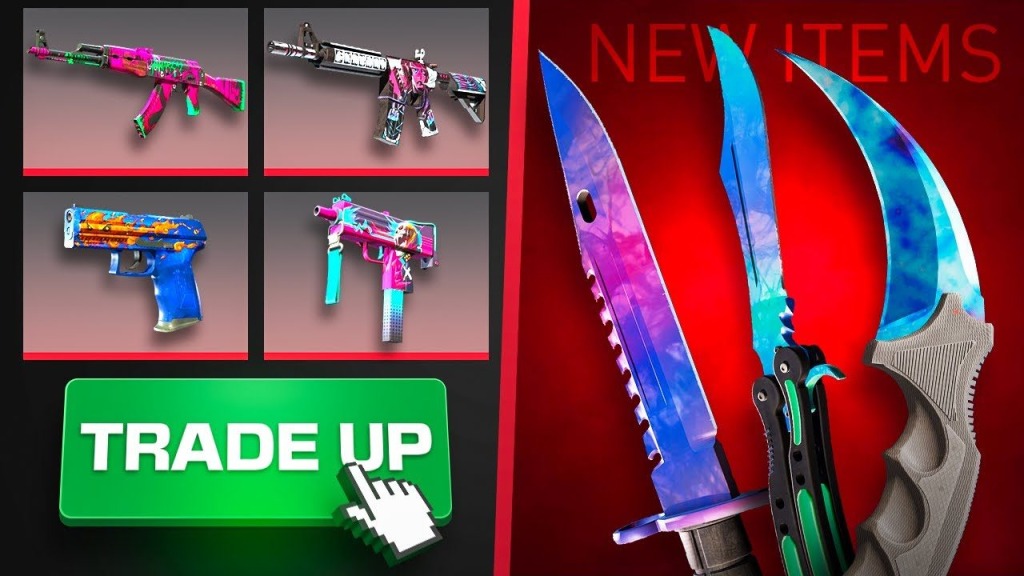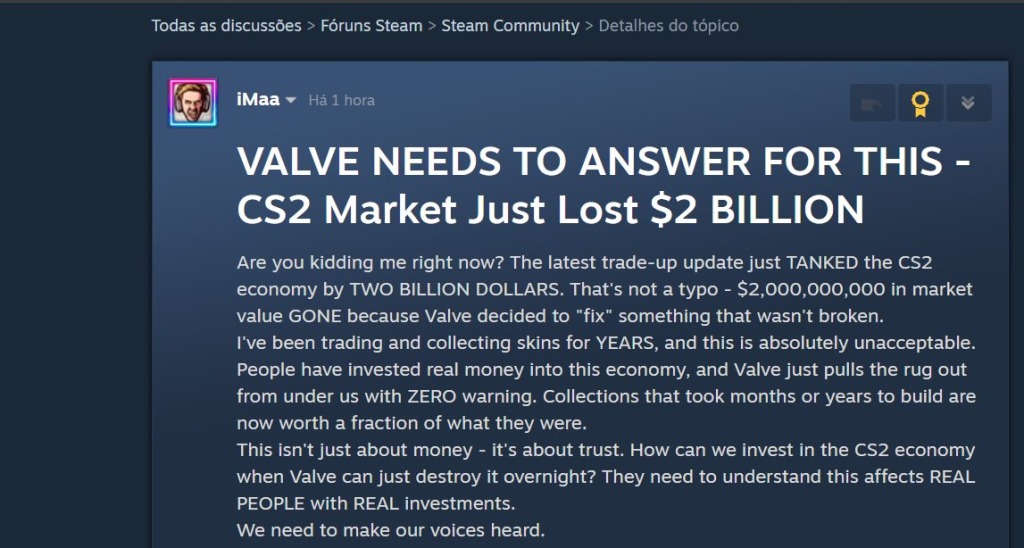
Counter-Strike 2’s digital collectibles market experienced one of gaming’s most severe economic collapses when item values dropped by up to 70% following an unexpected developer update. The Counter-Strike 2 skins market, known for its volatility and rapid price movements, lost approximately $1.784 billion within 24 hours.
Market tracking data reveals the CS2 skin market capitalization fell from nearly $6 billion to approximately $4.27 billion, representing a 28% decline that impacted millions of players. Valve’s update particularly affected knife collectors, with premium knife prices dropping hundreds of dollars in a single trading session.
The scale of this market disruption becomes clear when considering that CS2 skins generate annual transaction volumes between $1.5 and $6 billion. This crash highlights the vulnerability of digital gaming economies when developers implement sudden changes to established systems.
Valve Enables Knife Trade-Up System
Valve implemented a significant change to Counter-Strike 2’s trade mechanics on October 23, 2025, according to the Steam Community, expanding the Trade Up Contract system to include knife and glove crafting for the first time in Counter-Strike history. This update fundamentally altered how players can obtain the game’s most coveted items.
The expanded system operates on a straightforward exchange principle: five Covert (red) quality weapon skins can now be traded for either a knife or gloves. StatTrak™ variants follow the same pattern, with five StatTrak™ Covert items producing one StatTrak™ knife, while regular Covert skins yield either standard knives or gloves. The resulting items belong to the same collection as one of the traded skins.

Previously, rare knives and gloves remained accessible only through case openings with approximately 0.26% drop rates or direct Steam marketplace purchases at premium prices, until recently, says EuroGamer. The trade-up expansion created an alternative acquisition method that bypassed traditional scarcity mechanisms.
Valve announced this change through routine patch notes without highlighting its potential market impact. The understated presentation masked what would become a major economic shift as traders immediately began adapting their strategies to the new system.
CS2 Skin Market Crashes by $2 Billion
Market tracker PriceEmpire data shows Counter-Strike 2’s market capitalization dropped from approximately $6 billion to $4.1 billion, eliminating nearly $2 billion in value within a single day. This represents a 30% market decline over 24 hours.
High-value knives and gloves bore the brunt of the price corrections, with certain items losing up to 70% of their market value. Rare Butterfly Knives that previously traded at $20,000 now sell for significantly reduced amounts. Conversely, previously low-cost Covert skins experienced dramatic price increases items worth under $5 yesterday now command prices exceeding $40.
The update fundamentally altered the supply dynamics for Counter-Strike’s premium items. Market conditions essentially reset to levels last seen seven months ago.
However, some analysts view this as temporary market panic rather than sustained devaluation. FloatDB analysis suggests that even if every eligible skin underwent trade-up conversion, an improbable scenario, knife supply would only increase from 5.5 million to 11 million units.
Former YouTube gaming head Ryan Wyatt identifies confidence as the primary issue rather than supply concerns: “It’s more a confidence issue. It’s this today, what tomorrow?”
Players React to Sudden Devaluation

Counter-Strike community reactions split along economic lines as players processed the market collapse. Knife collectors voiced frustration after watching their investments lose substantial value, with one player reporting their knife dropped $1,400 in just 30 minutes.
Trading forums erupted as investors tracked their diminishing portfolios. “My Butterfly Fade dropped from $2300 to $1800 in 10 hours. And it’s still falling,” reported one Reddit user. The severity of losses prompted concerns from streamer FURIOUSSS, who noted, “You guys know that people are probably going to harm themselves cause of this, yet you pushed it out without hesitation, crazy”.
Casual players responded differently, celebrating access to previously expensive items. “It’s given me faith that Valve is actually steering in a direction that favors the average player,” wrote one Redditor.
Content creator austincs described the update as “probably one of the worst updates for skin owners in CS2’s history”, calling the situation “an unprecedented collapse for digital items in gaming.” Professional player Spinx posted his reaction: “Skins are over, I am out”.
Industry analysts suggest Valve’s move targets third-party marketplaces and gambling sites, potentially redirecting transactions to Steam’s official marketplace, where the company collects transaction fees.
Conclusion
Counter-Strike 2’s market collapse represents a defining moment for digital gaming economies. Valve’s knife trade-up implementation has fundamentally altered how players approach virtual item investment, creating a permanent shift in market dynamics that extends beyond temporary price fluctuations.
This event exposes the reality of digital ownership within gaming ecosystems. Items worth thousands of dollars remain subject to developer decisions, regardless of their perceived market value or community investment. The psychological impact on collectors appears more significant than the immediate financial losses, as trust in the stability of virtual economies has been severely damaged.
Community reaction reveals the sharp divide between different player demographics. Casual players view this change as democratizing access to premium items previously available only to wealthy collectors. Meanwhile, serious investors face the harsh lesson that virtual markets lack the protections found in traditional financial systems.
Valve’s long-term strategy becomes clearer when examining the broader implications. The update potentially redirects transactions away from third-party marketplaces back to Steam’s official platform, where the company maintains control and collects transaction fees. This shift represents more than market manipulation it demonstrates how developers can reshape entire economic ecosystems through a single update.
The Counter-Strike community must now adapt to this new reality. Whether this crash signals a permanent reduction in skin values or a temporary market disruption remains unclear. What has become certain is that digital gaming economies can experience dramatic changes overnight, regardless of their size or established trading patterns.
For both collectors and casual players, this collapse serves as a reminder about the nature of virtual assets. The CS2 market crash may eventually be remembered as the moment when gaming communities truly understood the fragility of digital ownership.





















